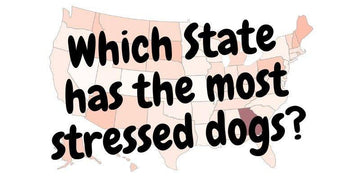As caring and responsible dog owners, we all want our dogs and fellow family members to be happy. Part of this happiness is ensuring the stress and anxiety levels in our dogs are kept to a minimum.
We know that dogs, often referred to as 'man's best friend', share a unique bond with humans, resonating with our joys and sorrows alike. Through a process called 'emotional contagion', dogs can emulate our emotional wellbeing.
Whether we are stressed or happy, our emotional state is also going to affect theirs.
Table of Contents
- Background
- Methodology
- Data Collection
- Data Processing
- Results
- Overall Dog Stress Levels Heatmap
- Top 5 States with the Most Stressed Dogs
- The 5 States with the Least Stressed Dogs (The Most Chillaxed Dogs)
- Distribution of Dog Stress Levels Across States
- Dog Stress Level Across The USA Regions
- Most and Least Stressed Dogs in All 50 States - Descending Order
- Is there a link between the number of dogs owned and their levels of stress?
- Key Findings/ TL;DR
- Study Limitations
- Study Conclusions
With the majority of research so far focused on human stress and anxiety, we couldn't find much data related to our dogs. But since dogs are becoming more and more important to our daily lives, we wanted to take a deeper look into their mental wellbeing.
Could a dog's stress level depend on which state they live in?
Our research has unveiled intriguing regional patterns in the United States, highlighting states where dogs seem to be the most and least stressed.
This discovery not only sheds light on the myriad factors that might influence a dog's emotional state but also beckons a deeper exploration into the symbiotic relationship between environment, ownership practices, and canine well-being.
Let's see how we conducted our research and what this has shown.
Data is accurate as of Aug 2023.
Background
Over centuries dogs have become domesticated and transitioned from wild wolves to our closest companions. They now mirror our emotional cues, forming bonds that transcend mere companionship.
Stress in dogs, similar to humans, is a complex interplay of environmental, physiological, and psychological triggers.
An unfamiliar sound, a sudden change in living conditions, or even the absence of a beloved family member can send ripples of anxiety through a dog's psyche. Separation anxiety especially, is more common than we think.
But what's more intriguing is the regional variations in these stress levels. Why might a dog in Georgia experience different stress levels than one in Wyoming?
Why do both North and South Dakota have some of the lowest stress levels in dogs? Is it the urban hustle and bustle, the varying climate, or perhaps the cultural approach to pet ownership?
Methodology
We first started with our data collection. The primary aim was to decode the regional variations in dog stress and identify potential factors that might influence these differences.
Here's a step-by-step breakdown of the approach.
Data Collection
Search Data
We first used Ahrefs to identify top 10 terms related to dog anxiety in all of the United States. We identified these to be the following:
|
dog calming treats |
|
dog calming chews |
|
separation anxiety |
|
dog calming music |
|
dog anxiety |
|
dog anxiety meds |
|
dog anxiety treatment |
|
how to calm an anxious dog |
|
how to calm a dog down |
|
dog depression |
We then went to Google Keyword Planner to confirm our data and expand it to include 10 more suggested terms that also ranked high.
In total, we identified the following 20 keywords to have the highest search traffic AND be the most relevant to "dog anxiety" or "dog stress" search intent. This search intent could either be information or commercial, as you can see from the identified keywords.
These are the 20 keywords used and their average search volume:
|
Keyword |
Average Monthly Searches (US wide) |
|
dog calming treats |
50,000.00 |
|
dog calming chews |
5,000.00 |
|
separation anxiety |
50,000.00 |
|
dog calming music |
5,000.00 |
|
dog anxiety |
50,000.00 |
|
dog anxiety meds |
50,000.00 |
|
dog anxiety treatment |
5,000.00 |
|
how to calm an anxious dog |
5,000.00 |
|
how to calm a dog down |
5,000.00 |
|
dog depression |
5,000.00 |
|
separation anxiety in dogs |
50,000.00 |
|
thundershirt for dogs |
50,000.00 |
|
separation anxiety disorder |
5,000.00 |
|
separation anxiety adults |
5,000.00 |
|
thunder jacket for dogs |
5,000.00 |
|
music for dogs |
5,000.00 |
|
zesty paws calming bites |
5,000.00 |
|
attachment anxiety |
50,000.00 |
|
dog anxiety symptoms |
5,000.00 |
|
best calming treats for dogs |
5,000.00 |
In total, there were 415,000 monthly searches of these 20 search terms from Sep 2022 to Aug 2023. This is equivalent to about 5 million searches per year.
We therefore felt confident that using these search terms at State level would give our study enough power for the analysis.
Population Data
Given the disparate population sizes across states, it was crucial to standardise our metrics.
We therefore sourced population data to provide a denominator for our calculations.
By doing so, we could accurately compare across California for example with a population of over 40 million, and Wyoming with a low population of 570,000.
To keep our data reliable, we actually decided to use the "Reach" data for each state provided by Google.
Google says that "Reach is an estimate of how many people are in, or interested in, the location you select. It's based on the number of signed-in users visiting Google sites."

By using this "Reach" population data instead of the census, it allowed us to capture the accurate location of those who may live in one state, but performed the search from abroad or from another state.
Either way, we checked the consistency of the census data and the Reach data and the usual margin of error was only about +/- 8%.
Data Processing
We made use of the GPT-4 Advanced Data Analysis function to accurately analyse our data.
Aggregation
First, the search queries were aggregated for each state to derive a cumulative value.
This value then represented the overall stress-related search volume for each state.
This is what the initial query looked like:

Standardisation
Secondly we had to standardise the above results to account for population differences.
The metric used was "searches per 1,000 individuals," allowing for an apples-to-apples comparison across states.

The output from this was a "ratio of search per 1,000 people for each state".
This ratio is what we decided to use as a proxy for the stress levels in each state. By standardising it for each state's population level, we could now provide a direct comparison.
Data Interpretation
With the processed data now available we sought to now interpret the findings, draw insights, and hypothesize potential reasons for the observed patterns.
By adhering to this methodology, the research sought to provide a comprehensive and objective analysis of dog stress levels across the U.S. We aimed to offer valuable insights for pet owners, veterinarians, and policymakers.
Furhermore, we also used pet ownership data in our analysis to identify other various correlations.
Results
Our analysis, based on search data aggregated from various states across the U.S., revealed intriguing patterns related to dog stress levels.
This search data was normalised using state-wise population figures to provide a more balanced perspective, which we've termed as "Stress Level".
Overall Dog Stress Levels Heatmap
This heat map shows you the breakdown of dog stress levels by state, according to our data. The two most stressed states are Georgia and Maine, with the rest shown below (download high res).

Top 5 States with the Most Stressed Dogs
1. Georgia (3.18 monthly searches per 1000 people)
2. Maine (1.67 monthly searches per 1000 people)
3. New Hampshire (1.53 monthly searches per 1000 people)
3. South Dakota (1.48 monthly searches per 1000 people)
5. Arizona (1.47 monthly searches per 1000 people)

Georgia
Georgia quite clearly tops the list as the state with the most stressed dogs according to our findings. Interestingly, the search volume for the dog stress related keywords identified outweighs the other states by a large margin. You could theoretically classify it as an outlier. But why is that?
In the last year, there were on average 3.18 monthly searches related to dog stress or dog anxiety.
We are not quite sure what the reason behind this huge difference compared to the other states.
There could be a link with the rapid urban sprawl, coupled with high-density populations in cities like Atlanta. All this might lead to reduced open spaces for canine recreation such as dog parks.
Another reason could be that the subtropical climate, characterised by hot and humid summers, could also amplify discomfort. However, we don't see the same effect in other subtropical states.
It could also simply mean that the owners' awareness of stress and anxiety in dogs is higher in Georgia when compared to the rest of the country. In fact, this seems the most likely explanation.
This stress data is confirmed by a recent report in which three Georgia cities made the list of most stressed cities in America ranking in the top 25%. 51% of people in Georgia also said that they are "very stressed" financially.
It's possible that the explanation for our findings is that owners are transferring their stress and anxiety to their dogs.
After all, in 2023, 44.3% of adults in Georgia reported symptoms of anxiety or depression. This figure is much higher than the national average.
There might even be an element of overmedication. If a dog owner is stressed and already medicating, they might think their dog is also expressing signs of anxiety. They are therefore more likely to search online and start medicating their dog as well.
Maine, New Hampshire, South Dakota and Arizona also have plenty to work on in terms of improving the stress levels for their dogs. However, they are much closer to the average across the U.S.
The 5 States with the Least Stressed Dogs (The Most Chillaxed Dogs)
1. Missouri (0.62 monthly searches per 1000 people)
2. Nevada (0.63 monthly searches per 1000 people)
3. Colorado (0.65 monthly searches per 1000 people)
4. Louisiana (0.73 monthly searches per 1000 people)
5. Minnesota (0.77 monthly searches per 1000 people)
Unlike with the most stressed states for dogs, the bottom 5 are less well differentiated.
Missouri

Interestingly, Missouri turned out to be the state with the most chilled dogs.
This is great news for the doggos living in Missouri and their owners too!
What could be the reason for this?
Well, when looking at the rest of central USA, it's quite obvious that this line of states from Nevada to Missouri have a lower level of stress compared to the rest of the country.

Three of the five lowest stressed regions in the USA belong to this central belt. The other two, Utah (6th least stressed) and Kansas (10th) are not far off.
Let's consider a few reasons for why this may be the case.
Rural areas often have more open spaces, which can lead to dogs having more freedom and space to roam, play and exercise. Just like in humans, these activities can contribute to reducing stress.
Rural areas also tend to have a slower, more relaxed pace of life compared to bustling urban centers. This relaxed environment might translate into less stress for both humans and their pets.
Another benefit of rural areas is that they tend to have closer knit communities.
Smaller towns and communities often have strong social ties, which can result in more communal activities, including those involving pets. The sense of community might foster a supportive environment for pet owners, leading to better care and reduced stress for dogs.
Let's not forget that socialising and a sense of belonging is one of the principles of longevity that we have learnt from those living in the Blue Zones. Could these few states be the new Blue Zones for dogs?
Distribution of Dog Stress Levels Across States
Here is what the disitribution of searches looks like. Apart from Georgia, the rest of the States are more evenly distributed.

Dog Stress Level Across The USA Regions
In terms of the vast USA regions, our research has shown the following:
Northeast (CT, MN, NY, etc.) has the highest dog stress levels overall. This suggests that dogs in the Northeast might experience more stress, or residents in this region are more active in seeking online information about dog stress.

West ranks second in the average search rate. The presence of both large urban centers and vast natural areas in this region might contribute to varying levels of dog stress.
The Midwest on the other hand shows the lowest average search rate. This region, known for its open spaces and agricultural land, might provide a more relaxed environment for dogs, leading to fewer stress-related searches.
Most and Least Stressed Dogs in All 50 States - Descending Order
The full list of all 50 states, starting from Georgia which is the most stressed, all the way to Missouri. Also including Hawaii and Alaska.
|
Rank |
State |
Dog Stress and Anxiety Related Searches per 1,000 Residents |
|
1 |
Georgia |
3.1818 |
|
2 |
Maine |
1.6667 |
|
3 |
New Hampshire |
1.5278 |
|
4 |
South Dakota |
1.4846 |
|
5 |
Arizona |
1.4692 |
|
6 |
Pennsylvania |
1.4465 |
|
7 |
Alaska |
1.4243 |
|
8 |
Idaho |
1.4031 |
|
9 |
Hawaii |
1.3603 |
|
10 |
Rhode Island |
1.3603 |
|
11 |
Michigan |
1.2476 |
|
12 |
Montana |
1.2389 |
|
13 |
Vermont |
1.2242 |
|
14 |
New Mexico |
1.2222 |
|
15 |
Washington |
1.2200 |
|
16 |
North Dakota |
1.2179 |
|
17 |
Wyoming |
1.1571 |
|
18 |
Nebraska |
1.1348 |
|
19 |
Ohio |
1.1292 |
|
20 |
Illinois |
1.1108 |
|
21 |
Tennessee |
1.0893 |
|
22 |
Massachusetts |
1.0796 |
|
23 |
Virginia |
1.0480 |
|
24 |
Florida |
1.0110 |
|
25 |
West Virginia |
1.0109 |
|
26 |
Indiana |
1.0065 |
|
27 |
Texas |
0.9946 |
|
28 |
Kentucky |
0.9881 |
|
29 |
California |
0.9764 |
|
30 |
Delaware |
0.9722 |
|
31 |
Mississippi |
0.9717 |
|
32 |
Connecticut |
0.9681 |
|
33 |
South Carolina |
0.9545 |
|
34 |
Maryland |
0.9435 |
|
35 |
Alabama |
0.8920 |
|
36 |
Oregon |
0.8850 |
|
37 |
Arkansas |
0.8767 |
|
38 |
North Carolina |
0.8675 |
|
39 |
Kansas |
0.8629 |
|
40 |
Iowa |
0.8548 |
|
41 |
Wisconsin |
0.8511 |
|
42 |
Oklahoma |
0.8449 |
|
43 |
New York |
0.8359 |
|
44 |
New Jersey |
0.8322 |
|
45 |
Utah |
0.8040 |
|
46 |
Minnesota |
0.7709 |
|
47 |
Louisiana |
0.7335 |
|
48 |
Colorado |
0.6471 |
|
49 |
Nevada |
0.6288 |
|
50 |
Missouri |
0.6159 |
Is there a link between the number of dogs owned and their levels of stress?
Part of our initial hypothesis was that dogs will be less stressed in a household that has multiple dogs.
Our analysis shows however that there is a very poor correlation of -0.116.
This suggests that the number of dogs in a household might not be a significant factor influencing the stress levels of dogs in a particular state, at least based on the metrics used in this analysis.
There was also no strong correlation between general pet ownership and dog stress levels.
Full Data
You can download the full results data for your own interest here.
Study Limitations
There are however some limitations for this study.
As no one has looked at such data before, it's difficult to know its accuracy. Using search data as a proxy for actual dog stress levels may not be the most accurate representation.
We were also fully reliant on the accuracy of the data obtained from Google.
Is Google Keyword data accurate?
Difficult to know when drilling down to state level, due to the lower frequency of searches. For example, there are only about 50 searches per month for "music for dogs" and "dog anxiety symptoms" in Alabama.
Finally, perhaps the largest limitation of all, is that Google only presents the data as a range, and then rounds it to the nearest 50, 500, 5000 or 50,000.
By applying the same methodology across the board, we hoped to minimise some of these limitations, but they could not be fully addressed.
Key Findings/ TL;DR
- Georgia appears to be the state with the most stressed dogs (when standardised across the US)
- Missouri is the state with the least stressed dogs across the U.S.
- A few groups of states in close proximity e.g. ME & NH, SC & NC, IN & KY have given similar results when adjusted for their own population. This appears to add to the validity of the study
- Central states from Nevada to Missouri have the least proportion of stressed dogs. Also, parts of the Midwest, which coincides with large rural agricultural areas. This validates our hypothesis that rural areas are less stressful for dogs.
- There is no correlation between dog stress levels and the number of dogs or cats in a household.
- Notable mentions:
- New York state is #43rd and New Jersey #44, both in the bottom 25th percent of most stressed dogs states
- Nevada, comprising Las Vegas is #49 out of 50, so despite the buzz in the city, dogs here are some of the least stressed and anxious.
- California has done quite well, ranking #29 which means the dogs living there are likely less stressed than the national average.
Study Conclusions
Us at Fetched were quite surprised by the results of this study. We expected the most populous States and cities to have dogs with higher stress levels. However, this has proven to be untrue.
New York, Chicago, and LA can therefore be glad that their dogs are not the most stressed in the country!
Overall, we can see a few patterns emerging, so I believe the data to be pretty accurate. Generally, the Northern and Southern states seem to be the most stressful for dogs.
On the other hand, the Western and Central states, such as Nevada, Colorado, Missouri, Utah and Kansas are the least stressful for dogs.
Do you have any questions, clarifications or would like to contribute your opinion? Can you spot any patterns we've missed? Please get in touch to have a chat!









